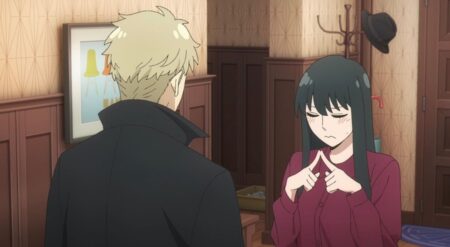As a whole, Onyx Equinox Season 1 aims to take anime viewers where they haven’t before – across Mesoamerica. Over the course of 13-episodes, the series tells the story of Izel (Olivia Brown), a young boy tasked with the quest of representing humanity as the “lowest of the low” in a game between the gods Quetzalcoatl (Zeus Mendoza) and Tezcatlipoca (Arin Hanson). His quest, close the five gates of the Underworld and save humanity from the next cycle of destruction. But the problem is that Izel has lost faith in humanity after his sister is sacrificed to protect their city.
But Izel isn’t alone in his quest. In Onyx Equinox Season 1, he’s joined by twin ulama players Yun (Patrick Pedraza) and K’in (Juan Arturo Maldonado), priestess Xanastaku (Kimberly Woods), warrior Zyanya (Carolina Ravassa), and the guardian of the wager, Yaotl, who is a part of the group to ensure that there is no godly interference. Over the course of 13 episodes, the group joins together to fight for humanity while also struggling to find a synergy between each other.
Onyx Equinox Season 1 is a brutal series featuring action sequences that deal in a lot of blood and destruction, largely propelled by the kaiju inspirations that drive the way the gods interact with humanity. But in gore and violence akin to Powerhouse Animations Seis Manos, the series also holds a beauty like I haven’t seen before. The cast features characters who are all brown-skinned. Their skin color is gorgeous and vibrant, with the animators using teals and purple to light it in a way that showcases each character’s innate beauty. The animation’s beauty is taken further as the team illustrates everyday life in Mesoamerican cities, their joy, and their vibrancy. While there is death in this series, there is also life. The joy in watching an ulama match and playing it, the life in a market, and the way the character laugh in times of peace.
But the darkness the series balances its joy is just as beautiful, even if it’s bloody. The gods and monsters of Onyx Equinox Season 1 are epic in scale, gorgeously designed, and their power is showcased not just in their beauty but also in their intimidating and sometimes grotesque imagery. In the debut episode, the gods rise from the ground like kaiju from the sea and lay waste to a city. As the story continues, the group encounters different gods, some who use dead things to build their bodies and others who show their true form or hide it in a beautiful guise. The animators capture the beauty and the terror the gods represent and how I was always taught to think about them.

While it is clear that humans are the gods’ playthings, there is a hopeful element to the series that showcases the power that humans can have as it explores the relationships between its characters. But while the animation drives my love for the series, episode eight is where my emotional connection to the characters hit. Having lost his sister, Izel has been struggling with his grief, but not only that, the burden of his quest. At every turn, Izel pushes away his quest, and as people around him begin to get hurt, he carries the weight of their loss. It’s then that we see the connections between our characters blossom and their growth take hold as they come together.
While Izel is the main character, he is surrounded by a cast of strong individuals. And while there is a soft spot in my heart for all of them, especially the dedicated and fierce Zyanya, Yun is the strongest human character of the series. He’s the group’s emotional core and offers words of wisdom that are pivotal to pushing Izel towards completing his quest. He pulls them all together into a found-family of characters that learn how to trust each other and forgive each other for their secrets and mistakes.
The mythology that the series brings to life spans Mesoamerica, considering the Olmecs, a society that existed thousands of years before the Aztecs, the Aztec (or Mexica) tales, and Mayan culture as well. The series does a phenomenal job at showcasing the longevity and influence of Mesoamerican culture and mythology as an ever-constant element of the world and not just something that existed for a brief moment before colonization. While not every element of the myths presented have an expository moment, every god is defined and given personality, and some of the larger themes of the myths are told to the audience.
In particular, Onyx Equinox Episode 3 offers a concise yet well-defined explanation of the cycles of destruction and creation. Like how Zeus created humans from different materials, destroyed one, and created a new one, so did the creator gods of the Mesoamerican cosmology. The narrative of Onyx Equinox Season 1 fits directly into the cycle, and more importantly, the series shows how life and death are loosely separated and how death is not the end, with some souls turning into new creatures and others facing the trials of the Underworld. The most elegantly mapped out example of this is Yaotl (Alejandro Vargas-Lugo). The guardian of Izel’s quest and the emissary of Tezcatlipoca, he is a jaguar being that holds the power of the underworld in his being and was once a human.
From sacrifices to cities, Onyx Equinox Season 1 does a great job of avoiding all of the tropes that look to classify Mesoamerican society as “savage.” Instead, the series showcases the detailed cosmology and the role humans play in it while making sure not to give in to the way media has represented Mesoamerican civilization in media before. The world of Onyx Equinox is vast and magical, in a way that I couldn’t have ever imagined before. The way it dives into the story of Mictecacihuatl (Fayna Sanchez) and Mictlantecuhtli, the Aztec Lady of the Dead and God of the Dead, respectively, is wondrous to behold.

In the series’ final episodes, the myth is shown through the sanctity it held to those living in Mesoamerica through rituals of mourning, not just sacrifice. The cultural place of death and the gods’ interaction and the roots of the current Dia de Muertos traditions on display from marigolds to bones. Truthfully, the series penultimate episode offers up the most detailed look at Aztec life, its beauty, and how their beliefs impacted it. The way we’re shown a god entering the human world uses tropes we’re used to seeing in Greek mythology to tell a story that those familiar can understand. The series also leaves many questions about Mesoamerican mythology unanswered, which will hopefully push viewers to research the legends that haven’t been told before.
But to bring the Mesoamerican cosmology to life, the series has to include indigenous Mesoamerican languages. From names to words to describe elements of the story, the writing stays true to the languages. But, this is where Onyx Equinox Season 1‘s flaw comes to light: The voice acting. While the series features a predominantly Latinx voice cast, the way the series approached the voice acting is less than ideal. The truth is that certain sounds like the “tl” show up in K’ich’e or Nauhatl but not in English and only appear in certain dialects of Spanish. Some of the actors have accents, some don’t, and others don’t pronounce the indigenous names correctly or, with the same intention and authenticity, across the board.
The lack of indigenous voice actors in the case is frustrating given the stellar talent that has been showcased the last few years. In lieu of that, finding voice actors familiar with the sounds needed to speak in those languages could have easily be done by finding actors with the experience of speaking a dialect of Spanish that does as well. The unbalanced nature of the voice acting is extremely apparent when the gods interact with Izel.
While I’m sure Olivia Brown is a great voice actress, in our protagonist’s role, her inability to say the names of gods or hold her own when acting opposite Alejandro Vargas-Lugo, the powerful voice of Yaotl makes some scenes hard to watch. Additionally, had the creatives behind the show chosen to have all actors have one consistent accent, it wouldn’t be jarring to hear the series move from non-anglicized versions of the words to ones clearly pronounced by English speakers.
In a series dedicated to bringing the mythology of Mesoamerica to life, this is its greatest oversight and one that I could not get over even after watching the final seven episodes one after the other with no wait time. The variance in vocal performance hurts the series’s immersive quality, but thankfully the series animation and story make-up for this – as does watching the Spanish dub of the series.
With that one critique in hand, Onyx Equinox Season 1 is a beautiful series and one that brought to life stories I heard growing up in a way that honors them without fetishizing them. While this isn’t a comprehensive story of mythology, it shouldn’t have to be. It’s a springboard into overlooked mythology and presents the groundwork for other series in the same vein. In a year that brought us many reimaginings of Greek myth, it’s beautiful to see a story that strays from the Greek path while using some of its elements like showcasing the imperfection of gods and the role of humans in the larger cosmos. That said, the series also brings with it shonen elements of growth and found family while also avoiding some of its more problematic tropes like paper-thin female characters.
Finally, with its final episode, Onyx Equinox Season 1 has an open ending that can point to a season two, which given the strength of the series, I hope comes soon, or is at least announced. Overall, Onyx Equinox is a series that everyone should watch. It’s dark, gorgeous, and a jumping-off point for people unfamiliar with Mesoamerican culture and myth to expand their concept of mythology outside of the stories of Zeus’ illegitimate children that we all know too well. While there is more to tell in this one story, I hope it’s success inspires more creatives to tell the stories of the world beneath the connected to ours through the cenotes and the feathered serpents in the sky.
Onyx Equinox Season 1 is available for streaming exclusively on Crunchyroll.
Onyx Equinox Season 1
-
Rating - 8/108/10
TL;DR
Onyx Equinox is a series that everyone should watch. It’s dark, gorgeous, and a jumping-off point for people unfamiliar with Mesoamerican culture and myth to expand their concept of mythology outside of the stories of Zeus’ illegitimate children that we all know too well. While there is more to tell in this one story, I hope it’s success inspires more creatives to tell the stories of the world beneath the connected to ours through the cenotes and the feathered serpents in the sky.








